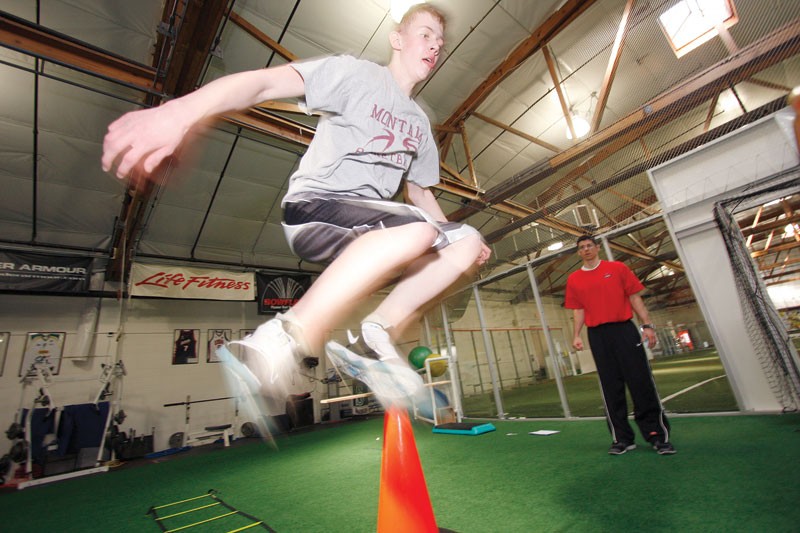
Eighteen million soccer moms can’t be wrong, can they? All that effort to cart their jersey-clad child athletes around the city three nights a week for practices and games — perhaps also toting teammates, siblings and a cooler full of Capri Suns. Please tell us they’re raising “active” kids?
Not quite. Researchers in San Diego recently tracked the physical activity of 200 young soccer players during games and practices and published their results in the journal Archives of Pediatrics & Adolescent Medicine.
While the authors found the kids’ participation “meaningful from a public health perspective,” they say only a quarter of them were getting enough exercise.
Spokane mom Marietta Estess has been part of her kids’ games and practices since kindergarten. Her sixth-grade daughter’s favorite is basketball; her third-grade son’s is soccer.
“He has two practices a week and a game, so I figured that’s three days a week exercising,” she says. And until she heard about the article, Estess hoped that was enough.
“Sometimes there is a lot of waiting their turn to try a skill,” Estess admits, “There’s just short sprints and stops. … It’s not a constant hour of exercise.”
So, as the authors of the study suggest, Estess creates other opportunities for her kids to stay active.
“We ski, and I make them ride their bikes while my husband and I walk. We do a lot of play dates,” she says. The Estess family has a large backyard with a sizable treehouse and a trampoline. “The kids run around the yard. My son will tell me, ‘I’m going out to play!’”
“Yeah, but then he just sneaks his Nintendo DS outside,” Estess’s daughter interjects. “He plays it behind a tree or inside the treehouse. He’ll be out there for, like, two hours and my mom will say, ‘Oh, good for you, you’re getting exercise.’”
In fact, whether they’re hiding it or doing it in plain sight, American kids aged 8 to 18 spend more than seven hours a day in front of TVs, computers, videogames, cell phones or movies.
Mario Williams, who helps run Spokane’s Kid Sports (the corporate headquarters for Soccer Tots and other pre-K sports programs), admits that electronics are a big deterrent to getting older kids involved in sports, so his programs start at 18 months.
“We engage kids through fun, made-up games. We’re secretly teaching them concepts of the sport, but we’re also building social skills, character, leadership, self-esteem and listening,” Williams explains.
“We use the ‘pull’ philosophy. ... If you push kids to participate, they naturally resist. If you can pull them in and engage them, make them think it’s on their own terms, they’re more likely to want to play.”
Williams says he hopes children who have early, repeated exposure to his preschool sports programs won’t need to count on their parents to “make” them go out and play later on.
“If the kids can grow up with a desire to be active … I think it carries on for their whole lives.”
But even kids who do have the drive to be active often haven’t learned the fundamentals of play.
When former Gonzaga basketball player Mike Nilson began his sports therapy business, U-District PT (which stands for Physical Therapy, Personal Training and Performance Training), he didn’t know he’d be teaching kids to skip and run sideways.
“We thought we’d be working with college-level athletes, but there’s a big need for young athletes,” he says. “Kids [today] are either more sedentary or they’re just playing one sport, but they’re not going through traditional patterns.”
By “traditional patterns,” Nilson means the ones we are supposed to learn playing for fun on blacktops and sports fields.
“It’s amazing how many kids don’t know how to squat, skip, lunge, run side to side, or rotate forward and back,” he says.
Since so many sports injuries are the result of sudden changes in direction, Nilson says it’s important to build an athlete’s agility.
Whether it’s through personal or team training sessions, youth camps or PE programs, Nilson says the first step to building a child’s lasting commitment to health and fitness is to “sell the mind.”
“We want our kids to love movement, to love working out and learning how the body functions,” Nilson says, noting that it’s not enough to teach a kid to run, jump, swing or kick with good form. “We want kids to link health and fitness with a the feeling of fun and success. It doesn’t have to be an organized sport,” he says. You can play hide-and-go-seek — crouching and squatting is great conditioning. You can go trail walking … whatever it is, find the child’s passion and create opportunities for them to make it happen.”
TIPS FOR ACTIVE FAMILIES
Studies show that kids are more likely to be active if they believe they are competent, skillful and supported by friends and families. The American Academy of Pediatrics recommends kids exercise for at least an hour every day, but it doesn’t have to occur all at once.
Give children toys that encourage activity — balls, kites, jump ropes.
Limit TV time and keep the TV out of a child’s bedroom.
Facilitate a safe walk to and from school once a week.
Make a new house rule: no sitting still during television commercials.
Encourage schools to hold recess prior to lunch to encourage physical activity before mealtime.
Volunteer to help with afterschool physical activity programs or sports teams.
Walk around the block after a meal.
Be sure that children get the sleep they need. A recent study found that with each extra hour of sleep, the risk of a child’s being overweight or obese dropped by 9 percent. Most children under age 5 need 11 hours of sleep, children 5 to 10 need 10 hours, and those over 10 need at least nine hours.
Source: www.letsmove.gov















